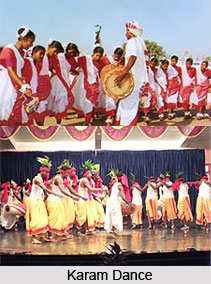 Karam dance is a folk dance of West Bengal state of India. It is basically an agriculture related festival and is performed by tribal communities like Oraon, Munda, Santhal and Ho. This ceremony supposedly summons the spirits of nature to ensure an abundant harvest. They have the belief that by the blessing of the God "Karam" they will get plentiful crops and their family will be saved from evil. This form of dance is thought to have soma mystic powers whereby the crops would be protected and would yield high productions. The Karam dance is performed on the night of "Bhado Ekadasi" which usually falls in the month of August.
Karam dance is a folk dance of West Bengal state of India. It is basically an agriculture related festival and is performed by tribal communities like Oraon, Munda, Santhal and Ho. This ceremony supposedly summons the spirits of nature to ensure an abundant harvest. They have the belief that by the blessing of the God "Karam" they will get plentiful crops and their family will be saved from evil. This form of dance is thought to have soma mystic powers whereby the crops would be protected and would yield high productions. The Karam dance is performed on the night of "Bhado Ekadasi" which usually falls in the month of August.
Performance of Karam Dance
This is a group dance where both male and female dancers participate enthusiastically. Karam dance is the rhythmic representation of the pastoral dance which is characterised by graceful postures and melodious notes. The songs are composed of few notes of close interval signifying the unconscious and slow progress of crops in the fields. Like the division of labour, the men and the women are divided into separate groups who participate in the dancing festival.
While dancing, the young men kneel down and the girls bend low over their bowed forms. They then sway their one arm in the air portraying the gesture of cutting the paddy crop. The man who leads the dance carries a chamar, meaning fan made from the wild date-palm leaf. He waves it over the field persuading it to yield in plenty. Before the Karam dance, the participants pray in a choir beseeching Mother Earth to fulfil the desires of her children.
During the harvesting of the crops the men and women work together. The dance at this stage represents the destruction of insect and other pests that damage the ripened grain. The men and women form a ring and dance in a circular pattern waving sticks which illustrates the killing of animals and birds. Musical instruments like `Dholl` and `Madal` accompany the dance.
Costume of Karam Dance
The dance performers clad themselves in their traditional attires. They adorn themselves with ethnic ornaments which usually include necklace, earring and bangle.



















